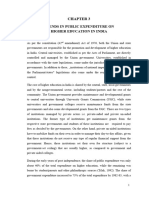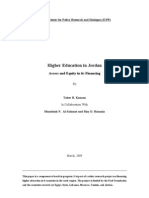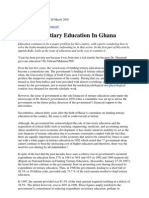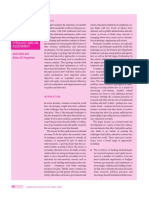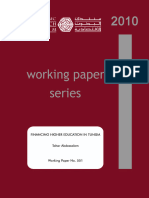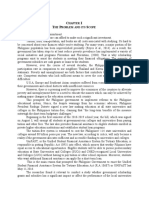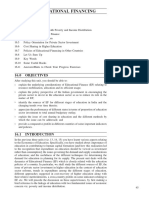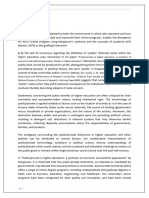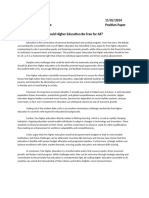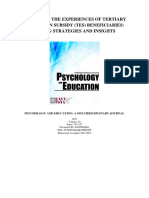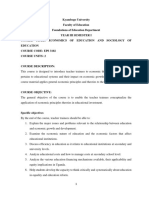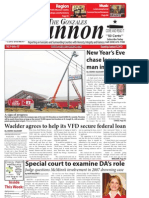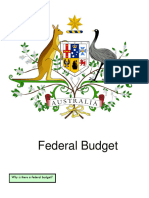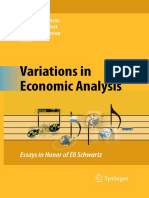0 ratings0% found this document useful (0 votes)
28 viewsHigher Education Between Funding Pressures and AcademicIndependence in Iraq
Higher Education Between Funding Pressures and AcademicIndependence in Iraq
Uploaded by
RD047Rahel RevaThe document discusses financing of higher education in Iraq, including the relationship between public and private funding sources. It outlines challenges including balancing adequate funding with independence of universities. Key factors discussed are direct and indirect economic returns on education investments and maintaining equal opportunities. Diversifying funding sources while ensuring inclusion is recommended.
Copyright:
© All Rights Reserved
Available Formats
Download as PDF, TXT or read online from Scribd
Higher Education Between Funding Pressures and AcademicIndependence in Iraq
Higher Education Between Funding Pressures and AcademicIndependence in Iraq
Uploaded by
RD047Rahel Reva0 ratings0% found this document useful (0 votes)
28 views7 pagesThe document discusses financing of higher education in Iraq, including the relationship between public and private funding sources. It outlines challenges including balancing adequate funding with independence of universities. Key factors discussed are direct and indirect economic returns on education investments and maintaining equal opportunities. Diversifying funding sources while ensuring inclusion is recommended.
Original Title
Higher Education between funding pressures and AcademicIndependence in Iraq
Copyright
© © All Rights Reserved
Available Formats
PDF, TXT or read online from Scribd
Share this document
Did you find this document useful?
Is this content inappropriate?
The document discusses financing of higher education in Iraq, including the relationship between public and private funding sources. It outlines challenges including balancing adequate funding with independence of universities. Key factors discussed are direct and indirect economic returns on education investments and maintaining equal opportunities. Diversifying funding sources while ensuring inclusion is recommended.
Copyright:
© All Rights Reserved
Available Formats
Download as PDF, TXT or read online from Scribd
Download as pdf or txt
0 ratings0% found this document useful (0 votes)
28 views7 pagesHigher Education Between Funding Pressures and AcademicIndependence in Iraq
Higher Education Between Funding Pressures and AcademicIndependence in Iraq
Uploaded by
RD047Rahel RevaThe document discusses financing of higher education in Iraq, including the relationship between public and private funding sources. It outlines challenges including balancing adequate funding with independence of universities. Key factors discussed are direct and indirect economic returns on education investments and maintaining equal opportunities. Diversifying funding sources while ensuring inclusion is recommended.
Copyright:
© All Rights Reserved
Available Formats
Download as PDF, TXT or read online from Scribd
Download as pdf or txt
You are on page 1of 7
DOI 10.15520/sslej.v7i01.40 http://sslej.in/index.
php/sslej Research Article
ISSN: 2456-2408 Social Science learning Education Journal
Higher Education between funding pressures and Academic
Independence in Iraq
Mazen Dawood Salman
Department of financial and Banking Sciences, College of Administration and Economics, University of
Baghdad, Iraq
Abstract: - The aim of Study to identify the obstacles and challenges of higher education in Iraq. Financing
of higher education is both important and sensitive. Higher education is costly, on one hand, and faces
competition from other important sectors for the distribution of public expenditure among these sectors, on
the other hand. The lack of adequate funding for higher education affects its quality on one hand, and its
access and diversity on the other, thus affecting the goals of economic efficiency and equity among the strata
of society. Therefore, reliance on public (government) funding is no longer sufficient and it is necessary to
rely on private sector funding, but taking into account students from poor segments. The contribution of
private companies and businesses, as well as contributions from charities and others to support higher
education and scientific research, can also be broadly and legally opened up, as recommended by research
to diversify the sources of education and achieve the independence of universities while maintaining the
principle of equal opportunities for all members of society.
Keywords: - Financing, Higher Education, academic independence, Higher education indicators.
1. Introduction: have been able to expand higher education while
The issue of financing for higher education raises increasing its quality without demanding a
several questions, including about the absolute substantial contribution from students and their
amount of expenditure and about the ratio of such families, but most developing countries need a
expenditure to other aspects of public expenditure or sustainable financing strategy for higher education.
as a proportion of GDP, or about its efficiency and These strategies are based on five components
its reflection on the quality of education. The source, increased public investment, Diversify corporate
sustainability and continuity of such expenditure, revenues by increasing cost-sharing. Expansion of
whether public or private, are also important issues the private sector, Growth in enrollment in technical
(MHAIBES & MAHMOOD, 2020). Therefore, education and vocational training and Expand the use
recent studies on the economics of education have of new performance technologies (OECD, 2010).
focused on the subject of financing higher education The importance of this research is that it discusses
and comparing the benefits generated by higher the sources and ratios of funding for higher education
education economically, socially and institutionally, in Iraq, especially in view of the financial pressures
on the one hand, with the costs borne by individuals, under Iraq's general budget as a result of the decline
Governments and society as a whole, on the other, in in oil prices. The purpose of this research; is to
order to generate an acceptable or profitable return or highlight the importance of government funding for
return at the level of the individual or society in higher education in an absolute and relative way, and
exchange for the sacrifice incurred. to assessment the cost of education in the Iraqi
In developing countries, the cost of providing higher education system in the private sector, The research
education is usually largely on the shoulders of hypothesis is that there is a direct link between
Governments, while in developed countries it is on private-sector funding for inclusive education on the
taxpayers in general, and this may raise several one hand, and university autonomy and
questions about the relationship of the most accountability on the other. Finally, the research
beneficiaries of the higher education system to those structure is based on two axes. The first is the
who pay the fair share of the cost. A few countries conceptual framework for financing and academic
Vol-07, Issue-01, 2022 Page no. 09-15 Page 9
Mazen Dawood Salman / Higher Education between funding pressures and Academic Independence in Iraq
independence of higher education. The second Level of satisfaction achieved in the demand for
focuses on methods and challenges of higher trained labour; this shows the importance of
financing, followed by conclusions and employment policies, forms of employment and the
recommendations. level of wages. Special demand for education; The
2. Conceptual framework for financing higher focus here is on the special rate of return on
education and its independence investment in education, fee levels, other forms of
2.1 Public-private funding options: social cost and other factors. Internal competence of
Increasing financial pressures on investment in educational institutions; which is expressed by the
education, combined with increased private demand relationship between input and output through the
for education, have led many Governments to indicators of waste, failure and abandonment. Firstly,
increase the contribution of students and their Geographical and social distribution of educational
families to financial support for funding through opportunities (Bassam, 2014). Impact of distribution
several cost-recovery mechanisms, including student of educational opportunities on income distribution
fees and loans. However, there are some who argue and the contribution of education to poverty
for supporting higher education. The first is that reduction and poverty rates (Barr & Crawford,
social benefits outweigh private benefits, prompting 2005).
Governments to support education in order to 2.2 Independence and academic freedom:
maintain the minimum required to invest in The term academic freedom was first used in the
education. The second argument concerns social United States in 1885, in Britain in 1901, and was
justice and equal opportunities, and lack of reliance founded in the United States in 1915 by the
on market forces and the private sector alone in the Declaration of Principles of the American Society of
provision of education (Abdul Rahman et al., 2021). University Professors (Brubacher & Rudy, 2017).
By contrast, with limited mechanisms to allocate The 1940 Declaration of Academic Freedom by the
public budget resources based on performance, State American Society of University Professors (AAUP)
institutions of higher education will not have specific defined academic freedom as the right of the faculty
administrative and financial incentives that make to have full freedom to research and disseminate the
them more innovative and enable them to use fruits of their research. (Barnes, 2019; Salman et al.,
resources more effectively. Rigid government 2021). The major principles of academic freedom
systems, in which institutions of higher education and independence include The freedom of a
operate, will not provide sufficient incentive and researcher to educate, investigate and discuss
flexibility to use limited resources in efficient and problems in his or her field of science, and to express
effective ways (Mhaibes, 2009). his or her findings through publication or teaching,
The third argument; Based on the principle that without the interference of politicians or
education is subject to economies of scale, achieving administrators, unless the means used by a
the principle of efficiency requires that the public competent body of his or her competence are clearly
sector burden core financing to benefit from inappropriate or contrary to the ethics of his or her
expansion and thus enter the private sector (Shore & profession. The right to participate in the
Wright, 2003). Generally speaking, before investing management of the institution and decision-making
in an educational project, the project owners must (Essam, 2012):
take into account the following criteria direct A. Free choice of research subjects.
economic returns on investment; this is by balancing B. Freedom of expression and free dissemination
the opportunity cost of resources with the expected of opinions and free interpretation of
future benefits of increased graduate productivity. knowledge through the media.
Indirect economic returns, through external benefits C. Freedom to engage in academic activities and
that affect the incomes of other members of society. activities.
Financial benefits; they are in the form of higher D. Freedom of travel and communication with
taxes paid resulting from the increase in income. other academics.
Vol-07, Issue-01, 2022 Page no. 09-15 Page 10
Mazen Dawood Salman / Higher Education between funding pressures and Academic Independence in Iraq
Academic independence is crucial for achieving to private funding from the family sector, to
international standards in scientific research and contributions from companies and foundations to
making use of them through dissemination and contributions from charities and others (Agarwal,
development, as well as providing opportunities for 2006).
creative minds to emerge and advance. The revival One of the challenges in financing higher education
of the innovation movement and the recording of is that public spending is unsustainable, as well as
inventions and publications in periodicals and economic constraints on universities that reduce
literature in the study and research centers is a efficiency incentives (Barr, 2004). so a three-element
positive indication of the absence of pressure from strategy could be proposed; Deferred variable fees,
funders (Altameemi & Flayyih, 2021). suspended income loans and effective measures to
With regard to the relationship of independence to enhance access to education, which are applicable in
finance, most of the world's evolving and mature a country that can collect income tax, and the
institutions include in their strategy a clearly stated challenge remains to finance higher education in
governance system regarding governance ways that enhance quality and avoid crowding out
independence, diversification of funding sources primary and secondary education (Lorimer, 2019).
such as partnership and marketing of services, as 3. The Results and discussions :
well as the role of private finance, relying on 3.1 Higher education funding trends and costs in
transparency, participation, accountability and the Iraq:
role of audit in the proper utilization of their Iraq launched the National Strategy for Higher
resources (Aebi et al., 2012). The main sources of Education and Education in Iraq for the period 2011-
funding for universities can therefore be identified 2020. The entry of Iraqi universities into the world
such as Receives funding from public rankings as a target and indicator of the quality of
administrations of the State. Students' contribution to higher education in Iraq. Adopting a true twinning of
some tuition. The commercial activity of universities Iraqi universities with important world universities
and the marketing of research aimed at generating through joint study, training and scientific research
revenue from commercial activities. In the Arab and output; reducing laxity, promoting academic
Islamic world, there could be another type of atmosphere, research and university life, and raising
financing based on a moratorium, such as Al-Azhar scientific standards.
University and Al-Zaytouna University, which gave Encourage the establishment of community-based
the best examples of financial independence (Essam, universities with global standards and quality,
2012). encourage parallel education in universities and
2.3 High-level financing methods and challenges: introduce distance education. Encourage investment
Financing for higher education is both important and in the expansion of government colleges and the
sensitive. Higher education is expensive, on the one upgrading of their scientific and academic levels by
hand, and faces competition from other important the Iraqi and foreign private sectors or by foreign
sectors for the distribution of public expenditure universities to provide expenditures outside the
among these sectors (McPherson & Schapiro, 2021). government budget. As for private university
The lack of adequate funding for higher education education (private education), legislation No. 25 of
affects its quality on the one hand, and the lack of 2016 has been enacted to update the laws in force and
access to and diversity on the other, thereby affecting to keep pace with developments in the world today.
both objectives (efficiency and equity). Reliance on The Higher Education Fund, established at the
public funding is no longer sufficient, and it is Centre of the Ministry of Higher Education and each
necessary to rely on private funding, but taking into university, college and institute, has moral
account students from poor backgrounds. In some personality and financial and administrative
developed and developing countries, the most independence. The resources of the Higher
important sources of funding for higher education Education Fund are determined by article 4 of the
range from funding for central to local governments, Ministry's Status, article 5 of the Universities and
Vol-07, Issue-01, 2022 Page no. 09-15 Page 11
Mazen Dawood Salman / Higher Education between funding pressures and Academic Independence in Iraq
article 6 of the Colleges and Institutes (Higher private sector funding. Table 1 shows that the
Education Fund Instruction No. 122 of 1999. The proportion of public expenditure on higher education
Ministry of Higher Education and Scientific is less than 2% for 2021 according to the draft
Research has also adopted a bill to amend the Federal Budget Act of Iraq and is close to the
Companies Act to allocate (1%) annual profits to previous year’s average of 2%. The 2 table estimates
companies and transfer them to the Scientific tuition premiums for the various private-sector levels
Research Fund for further details (site of the Ministry of teaching for the bachelor (primary) level only to
of Higher Education and Scientific Research of Iraq. range from an average of $ 3000 for human
In Iraq, higher education is funded primarily by specialties, $ 4000 for economic and administrative
central funding from federal budget public disciplines, $ 8000 for scientific studies, and $ 20000
expenditure allocations, which depend on for medical specialties.
government oil revenues of more than 90%, and by
Table (1) Ministry of Higher Education allocations from the general budget of Iraq for 2021
Total public Total capital Total operating
Details
spending expenditure expenditure
Ministry of Higher Education and
2,914,250,995 81,278,330 2,808,672,665
Scientific Research
Total 164,206,006,155 27,755,619,729 120,557,692,591
Relative importance* 1.78 0.29 2.33
Source: 2021 Federal Budget Project, p. 40-43.
* Calculated by researchers.
Table (2) estimate of the cost of years of study in Iraq (Iraqi dinar/USD)
Total cost in dollars $ at the Years of
School stage Total Cost (I.D.) Cost per year
)exchange rate of 1450I.D,1$) study
Primary school 5664 000110111 000110111 6
Middle school 3013 504110111 004110111 3
High school 3005 405110111 000110111 3
Total cost of primary,
middle and high school 00063 0000110111
education
Bachelors (humanitarian
3541 401110111 000410111 5
sections)
Bachelors (Scientific and – 0001110111 – 301110111
01661 -0004 4-5
Medical Departments) 3101110111 601110111
Master (private
4401 001110111 501110111 0
universities)
Ph.D. (Private universities) 00504 0001110111 601110111 3
Source: Researchers work based on interviews.
3.2 Indicators for students in higher education increase to the highest level in 2016/2017, then a
during the period 2014-2019 decline in 2017/2018 as the security situation
A number of facts can be drawn from table 3. The improved and displaced persons returned.
number of students admitted to higher education The number of teaching staff in university and
(government, private and technical) has increased by technical education also increased from 35,362 in
50% in just five years. Existing students grew by 2014/2015 to 49,753 in 2018/2019, an estimated
almost 38% over the same period, and if we move to 29% in about five years
students (heads, tenants and tarquins), there was an
Vol-07, Issue-01, 2022 Page no. 09-15 Page 12
Mazen Dawood Salman / Higher Education between funding pressures and Academic Independence in Iraq
School year Faculty Total graduate Total students Total students Total students
members students (depositors, deferred) present admitted
2014/2015 35362 100848 130005 574997 160013
2015/2016 38643 130428 134862 608554 148410
2016/2017 41233 144201 148569 647770 190292
2017/2018 47913 152467 124380 743825 233935
2018/2019 49753 148401 ------ 792553 241268
Source: University and Technical Education in Iraq for the academic year 2018/2019, Ministry of Planning,
Central Bureau of Statistics, Directorate of Social primary school graduates was 47.1% and graduate
and Educational Statistics, p. 5 and p7. graduates 40.7% during the five years of study. The
Table 4 also shows that one of the outcomes of the relative importance of graduates of State university
expansion of higher education (Government and education and private university education, and of
private) after 2003 in Iraq and the 50% increase in education in technical institutes was about 62%, 16%
the number of students admitted in five years is the and 20% respectively for the 2018/2019 academic
rise in annual growth rates in the numbers of both year.
primary and higher graduates. The increase in
Table (4) Graduates of Iraqi Universities by Universities
Graduates Graduates of Graduates of Graduates
Total total
School year Postgraduate of technical technical private of public
graduates
graduates institutes universities universities universities
2014/2015 8081 100848 18796 2134 21513 58405
2015/2016 7547 130428 20047 3064 26951 80426
2016/2017 7613 144201 23757 2858 27578 90008
2017/2018 9345 152467 29682 3124 31633 88028
2018/2019 11039 148401 30126 3126 24056 91093
The relative
importance of
each of the last
100 20.3 2.1 16.2 61,4
year's
university
%graduates
Source: Graduates of Higher Education in Iraq for the academic year 2018/2019, Ministry of Higher
Education, Central Bureau of Statistics, Directorate of Social and Educational Statistics, p. 13. cosit.gov.iq
Finally, a Table (5) shows the allocations obtained by some important State universities in Iraq, with a view
to achieving the objectives of the Government program without specific criteria. The University of Basra is
ranked first, followed by the University of Kufa and the University of Baghdad.
Table (5) allocations of the government development program for the most important Iraqi universities for
the year 2021 (million dinars)
University of University of University of University of University of University of
Baghdad Babylon Kufa Technology Basra Mosul
University of
Technology 446.6 964.9 381.6 1303.4 62.1
768.7
Al-Mustansiria Ministry Tikreet University of University of Al-iraqia
university Center University Anbar Nahrin university
678.9 12.6 455.8 356.7 260.2 23.6
Vol-07, Issue-01, 2022 Page no. 09-15 Page 13
Mazen Dawood Salman / Higher Education between funding pressures and Academic Independence in Iraq
Horizontal and vertical expansion in public and employment and employment in the government
private higher education took place after 2003 in sector after graduation.
general, with a marked continuation of this trend for 4. Conclusions:
the years 2014-2019, with student admission Emphasizing the importance of finding permanent,
reaching high levels of up to 50% in primary studies. stable and diversified sources of funding for higher
This shows the extent to which material and moral education in Iraq, and that the first step in reducing
needs from buildings, laboratories and other reliance on central specialties must be followed by
requirements have increased through qualified further steps to strengthen autonomy in universities;
teaching staff, which is not in line with the modest In order to provide independence to Iraqi
budget of the Ministry of Higher Education, which is governmental and private universities in particular, it
only 2% of the public budget. On the one hand, Iraq's is necessary to limit the role of the Ministry to
governmental universities continue to rely almost oversight, supervision, direction and accountability
entirely on public budget allocations, losing an in order to achieve the required transparency in both
important part of their independence and ability to public and private education. As a result of the
make important strategic decisions. On the other increase in graduates of higher education from
hand, the weakness of the allocations originally primary and higher education, which places a burden
allocated to higher education, ranging from only 2- on the labour market, decent employment
3% of public expenditure at best, which are subject opportunities to absorb higher education output
to cuts and rationalization in the event of an ad hoc become necessary and require the involvement of the
crisis, as we are witnessing today, is leading to private sector in solving this problem because the
economic difficulties for higher education, public sector cannot respond to labour market
particularly State education (university and variables in a flexible and rapid manner.
technical). The question of funding state higher Transparency in the management and development
education remains important and complex, and a of the Higher Education Fund and governmental
recent observation has been that evening education university funds as an auxiliary source of funding for
(which depends on the payment of premiums by educational institutions, especially during economic
students as well as special maintenance in graduate crises.
program) has succeeded in financing and paying References:
professors and lecturers through this channel. Also 1. Aebi, V., Sabato, G., & Schmid, M. (2012).
private (community) education, which played an Risk management, corporate governance, and
increasing role in higher education after 2003, bank performance in the financial
successfully financed itself and invested in the crisis. Journal of Banking & Finance, 36(12),
expansion to a large extent. Over the last five years 3213-3226.
2014-2019, however, the Corona crisis and declining 2. Agarwal, P. (2006). Higher education in India:
numbers of students enrolled at their own expense in The need for change (No. 180). Working paper.
both state and community universities (Private 3. Altameemi, A. L. I. H., & Flayyih, H. H.
sector) put additional pressure specifically on the (2021). A comparative Study in the Role of
private education sector. The proportion of graduates Private Sector in Relationships Analysis
for both primary and higher studies has increased to between Economic Sustainability and COVID-
47% and 37%, respectively, during the course of 19 : Evidence from Iraq and Russia UN Estudio
study. There has also been a shift in the structure of Comparativo sobre el Papel Del Sector Privado
higher education from government and private en el Análisis de las Relaciones entre la Sos.
universities and colleges towards technical institutes, 39(November), 1–13.
whose student ratio has increased. (17 to 20%) in less https://doi.org/10.25115/eea.v39i11.5842
than five years, because graduates of these private 4. Barnes, P. (2019). Academic independence,
medical institutes have higher chances of freedom and ‘enlightenment’: The case of
Vol-07, Issue-01, 2022 Page no. 09-15 Page 14
Mazen Dawood Salman / Higher Education between funding pressures and Academic Independence in Iraq
accounting research. Accounting ENRICHMENT STRATEGIES AND
History, 24(4), 591-609. ORGANIZATIONAL CREATIVITY
5. Barr, N. (2004). Higher education FUNCTION: A PERSPECTIVE FROM THE
funding. Oxford review of economic LEADERS OF THE MINISTRY OF OIL IN
policy, 20(2), 264-283. IRAQ. Journal of Sustainability Science and
6. Barr, N., & Crawford, I. (2005). Financing Management, 15(5), 140-150.
higher education (pp. 269-286). London: 15. OECD (2010). Reviews of National Education
Routledge. Policies (Higher Education in Egypt), and
7. Bassam, M. O. (2014). Financing and World Bank.
Economics of Higher Education, first edition, 16. RASHID, R. N., KAREEM, H. B., ALI, M. H.,
Wael Publishing House, Amman-Jordan. & HASAN, M. F. (2021). The Role of Internal
8. Brubacher, J. S., & Rudy, W. (2017). Higher Control Techniques in Sustainable
education in transition: A history of American Development to Improve Financial
colleges and universities. Routledge. Performance. Estudios de Economia Aplicada,
9. Essam, B. Y. (2012). Academic Independence 39(11), 1–14.
and the Issue of Finance, Annual Conference of https://doi.org/10.25115/eea.v39i11.6324
Centers for Political Studies and Strategic 17. Salman, M. D., & Mohammed, A. H. (2020).
Studies in the Arab World: Geostructure Shifts The Development of the Banking Sector's
in the Context of Arab Revolutions, 15-17. Contribution to the Iraqi Economy: Subject
10. Lorimer, B. A. (2019). Sustainable construction Review. Ishtar Journal of Economics and
industry strategies in South Africa: Business Studies (IJEBS), 11, 1-13.
Specialization vs Diversification (Master's 18. Salman, M. D., Mohammed, A. M. R. H., &
thesis, Faculty of Engineering and the Built Flayyih, H. H. (2021). Financial Safety
Environment). Indicators under Financial Crises and their
11. Maseer, R. W., & Flayyih, H. H. (2021). A Impact on Banking Finance : An Applied Study
Suggested Approach to Use a Decision Tree to in Iraqi Banks Indicadores de Seguridad
Rationalize the Decision of Accounting Financiera Bajo Crisis Financieras y su Impacto
Information Users under the Risk and en la Financiación Bancaria : Un Estudio
Uncertainty Un Enfoque Sugerido para Utilizar aplicado en los Banc. 39(November), 1–10.
un Árbol de Decisiones para Racionalizar la https://doi.org/10.25115/eea.v39i11.5923
Decisión de los Usuarios de Información Co. 19. Shore, C., & Wright, S. (2003). Coercive
39(November), 1– accountability: the rise of audit culture in higher
https://doi.org/10.25115/eea.v39i11.5877 education. In Audit cultures (pp. 69-101).
12. McPherson, M. S., & Schapiro, M. (2021). The Routledge.
student aid game. Princeton University Press. 20. Vinoth, S., Vemula, H. L., Haralayya, B.,
13. Mhaibes, H. A, (2009), ADOPTION OF Mamgaind, P., Hasan, M. F., & Naved, M.
international Awards Criterions FOR quality (2021). Application of cloud computing in
TO ACHIEVE THE excellence performance, A banking and e-commerce and related security
thesis submitted to Council of college threats. Materials Today: Proceedings, 1-4.
administration and Economics- Baghdad https://doi.org/10.1016/j.matpr.2021.11.121
university Partial fulfillment of requirements
for the MSc degree in public Administration.
14. MHAIBES, H., & MAHMOOD, H. A. (2020).
THE DIFFERENTIATION IN WORK
Vol-07, Issue-01, 2022 Page no. 09-15 Page 15
You might also like
- 행복을찾아서 대본Document28 pages행복을찾아서 대본Sang Hwa LeeNo ratings yet
- 11 - Chapter 3Document18 pages11 - Chapter 3intexcloud978No ratings yet
- Financing Higher Education in JordanDocument49 pagesFinancing Higher Education in Jordanurdunmubdi3100% (1)
- Chapter Six Financing EducationDocument8 pagesChapter Six Financing EducationKaren May UrlandaNo ratings yet
- S4 CheboiDocument24 pagesS4 Cheboicristina2908No ratings yet
- Allama Iqbal Open University, Islamabad Assignment No.1: Student InformationDocument25 pagesAllama Iqbal Open University, Islamabad Assignment No.1: Student InformationUsman MalikNo ratings yet
- Chapter 1-3 PROPOSAL WITH SURVEY QUESTIONNAIRE ECONOMIC IMPACTDocument52 pagesChapter 1-3 PROPOSAL WITH SURVEY QUESTIONNAIRE ECONOMIC IMPACTMary Chris Saldon BalladaresNo ratings yet
- Chapter Six Financing EducationDocument8 pagesChapter Six Financing EducationKaren May UrlandaNo ratings yet
- The Debate Surrounding Around The Issues With Financing Higher EducationDocument2 pagesThe Debate Surrounding Around The Issues With Financing Higher EducationUnmilan KalitaNo ratings yet
- CAMBRIDGE PAPERS 15(1)Document2 pagesCAMBRIDGE PAPERS 15(1)FrancisNo ratings yet
- .....Document24 pages.....dianamanuel3910% (1)
- Public-Private Partnerships: The Private Sector and Innovation in EducationDocument16 pagesPublic-Private Partnerships: The Private Sector and Innovation in EducationreasonorgNo ratings yet
- State Funding of Private EducationDocument5 pagesState Funding of Private EducationEdmar PaguiriganNo ratings yet
- Educational FinancingDocument19 pagesEducational FinancingA KNo ratings yet
- Public Subsidies in Education in IndiaDocument18 pagesPublic Subsidies in Education in Indiasocial.86420No ratings yet
- A2 Market Failure Tuition Fees Case StudyDocument6 pagesA2 Market Failure Tuition Fees Case Studypunte77100% (1)
- Rationale in Financing EducationDocument15 pagesRationale in Financing EducationKaren May UrlandaNo ratings yet
- European JournalDocument20 pagesEuropean JournalimmieeNo ratings yet
- Financing Higher Education in Algeria Reality and ChallengesDocument16 pagesFinancing Higher Education in Algeria Reality and Challengesanon_551766026No ratings yet
- Inclusion Policies HEDocument27 pagesInclusion Policies HEhoracio.detorresNo ratings yet
- Higher Education FundingDocument21 pagesHigher Education FundingJosé Manuel Tovar HerreraNo ratings yet
- Funding Education, PostgragraduateDocument11 pagesFunding Education, PostgragraduateJeffrey Owusu BanaheneNo ratings yet
- Economics of Education Hand OutDocument34 pagesEconomics of Education Hand OutOeNo ratings yet
- Iit Delhi Proposal (Vimal Verma)Document6 pagesIit Delhi Proposal (Vimal Verma)Satendra KumarNo ratings yet
- 6E高等教育资源配置机制的类型学与评价Document24 pages6E高等教育资源配置机制的类型学与评价帅颖No ratings yet
- fd8d89b4-8516-40dd-9ad7-09b874ad06d0Document34 pagesfd8d89b4-8516-40dd-9ad7-09b874ad06d0examlab1221No ratings yet
- International Comparisons in Higher Education FundingDocument27 pagesInternational Comparisons in Higher Education FundingHammad SalahuddinNo ratings yet
- ISIP, Katrina Mae P. - Article Review (Chapter 1-5)Document5 pagesISIP, Katrina Mae P. - Article Review (Chapter 1-5)katykat101001No ratings yet
- Cost of University EducationDocument5 pagesCost of University Educationabdurahmonov.fayzullo2000No ratings yet
- Available Among Teacher Education Students 1 AutosavedDocument10 pagesAvailable Among Teacher Education Students 1 Autosavedparillamaebel22No ratings yet
- Edu 1010 2Document6 pagesEdu 1010 2Francis MbeweNo ratings yet
- Public Private Partnership PaperDocument5 pagesPublic Private Partnership Papergkiyer7No ratings yet
- Final Draft Report of The Working Group On Fee-FreeDocument101 pagesFinal Draft Report of The Working Group On Fee-FreeAustil Mathebula100% (1)
- Irena Macerinskiene Birute VaiksnoraiteDocument9 pagesIrena Macerinskiene Birute VaiksnoraiteNeeraj KumarNo ratings yet
- Demand For EducationDocument2 pagesDemand For Educationrajvanshananya25No ratings yet
- Hs4350 BlogDocument6 pagesHs4350 Bloganon_34167850No ratings yet
- The Commercialization of Education: Hazards and Benefits in Public and Private Schools Within Guimba Nueva EcijaDocument38 pagesThe Commercialization of Education: Hazards and Benefits in Public and Private Schools Within Guimba Nueva EcijaMaria Camille Villanueva SantiagoNo ratings yet
- For References CheckingDocument46 pagesFor References CheckingSandra Pogoy AñascoNo ratings yet
- Higher Education in IndiaDocument5 pagesHigher Education in Indiamukul baijalNo ratings yet
- Block 5 MEC 008 Unit 16Document19 pagesBlock 5 MEC 008 Unit 16Adarsh Kumar GuptaNo ratings yet
- Final Assignment SPV Ayesha KutayDocument11 pagesFinal Assignment SPV Ayesha KutayAyesha KutayNo ratings yet
- Jan 11, 2002: Mark Yudof, "Is The Public Research University Dead?"Document4 pagesJan 11, 2002: Mark Yudof, "Is The Public Research University Dead?"Chris NewfieldNo ratings yet
- Clarisse Gulosino and Jonah Liebert 2012 - Review of The Way of The Future, Education Savings Accounts For Every American FamilyDocument12 pagesClarisse Gulosino and Jonah Liebert 2012 - Review of The Way of The Future, Education Savings Accounts For Every American Familyluiz carvalhoNo ratings yet
- Position PaperDocument1 pagePosition Paperlaureano rizonNo ratings yet
- Some People Express Their View That The Government Should Cover The Course Fees For All University StudentsDocument4 pagesSome People Express Their View That The Government Should Cover The Course Fees For All University StudentspdaoanhthuNo ratings yet
- The Effects of Elite Public Colleges On Primary and Secondary SchoolingDocument14 pagesThe Effects of Elite Public Colleges On Primary and Secondary Schoolingkelvincoar2017No ratings yet
- International Journal of Educational Development: SciencedirectDocument4 pagesInternational Journal of Educational Development: SciencedirectSari NNo ratings yet
- Public Subsidies in Education in India: Pecial ArticlesDocument17 pagesPublic Subsidies in Education in India: Pecial ArticlesHjsd JhNo ratings yet
- Paper 3 - EducationDocument3 pagesPaper 3 - Educationduryad32No ratings yet
- Assignment 1 828Document19 pagesAssignment 1 828Rabia ChNo ratings yet
- Hesa 772 Research Paper BittnerDocument14 pagesHesa 772 Research Paper Bittnerapi-650169045No ratings yet
- 2004-educational-economics (1)Document68 pages2004-educational-economics (1)Challef DNo ratings yet
- Examining The Experiences of Tertiary Education Subsidy (TES) Beneficiaries: Coping Strategies and InsightsDocument12 pagesExamining The Experiences of Tertiary Education Subsidy (TES) Beneficiaries: Coping Strategies and InsightsPsychology and Education: A Multidisciplinary JournalNo ratings yet
- Mum AssignmentDocument3 pagesMum AssignmentkingdavsmartNo ratings yet
- Chapter 2 Human CapitalDocument8 pagesChapter 2 Human CapitalkasuNo ratings yet
- Public Finance ASSIGNMENTDocument22 pagesPublic Finance ASSIGNMENTKazi rakibNo ratings yet
- Economics of Education and Socioogy of EducationDocument54 pagesEconomics of Education and Socioogy of EducationSsentongo NazilNo ratings yet
- 1 s2.0 S2199853122010587 MainDocument21 pages1 s2.0 S2199853122010587 Mainseyfullayev.ferid1No ratings yet
- UntitledDocument32 pagesUntitledChemutai EzekielNo ratings yet
- Ability and Willingness To Pay For University Education in Calabar, NigeriaDocument7 pagesAbility and Willingness To Pay For University Education in Calabar, NigeriaAlexander DeckerNo ratings yet
- Innovations in Knowledge and Learning: Postsecondary Education Reform to Support Employment and Inclusive GrowthFrom EverandInnovations in Knowledge and Learning: Postsecondary Education Reform to Support Employment and Inclusive GrowthNo ratings yet
- Hassan Ali Qureshi Assignment 2 CTBE Roll 13833Document5 pagesHassan Ali Qureshi Assignment 2 CTBE Roll 13833Zee DesignNo ratings yet
- UBL-Fund Managers Report-Jan-2024Document48 pagesUBL-Fund Managers Report-Jan-2024aniqa.asgharNo ratings yet
- CAP's Plan For Budgeting For Growth and ProsperityDocument2 pagesCAP's Plan For Budgeting For Growth and ProsperityCenter for American ProgressNo ratings yet
- Smart Governance: A Roadmap For Research and Practice: Hans J. Scholl and Margit C. SchollDocument14 pagesSmart Governance: A Roadmap For Research and Practice: Hans J. Scholl and Margit C. SchollBrughe BaeNo ratings yet
- Public PolicyDocument259 pagesPublic PolicyCBSE UGC NET EXAMNo ratings yet
- Debt Owed by The Central BanksDocument8 pagesDebt Owed by The Central Bankskaren hudesNo ratings yet
- Programmazione e Controllo Esercizi Capitolo 7aDocument14 pagesProgrammazione e Controllo Esercizi Capitolo 7aMavzky RoqueNo ratings yet
- PAD 4223 Chap 009Document11 pagesPAD 4223 Chap 009Amy99999No ratings yet
- Introduction To The Historical Tables: Structure, Coverage, and ConceptsDocument25 pagesIntroduction To The Historical Tables: Structure, Coverage, and ConceptsimplyingnopeNo ratings yet
- The Wall Street Journal April 24 2020 PDFDocument49 pagesThe Wall Street Journal April 24 2020 PDFmuzeucojusnaNo ratings yet
- Community Nutrition in Action An Entrepreneurial Approach 7th Edition Boyle Test Bank DownloadDocument20 pagesCommunity Nutrition in Action An Entrepreneurial Approach 7th Edition Boyle Test Bank DownloadVickie Montejo100% (20)
- RSC 2023 Budget Final VersionDocument122 pagesRSC 2023 Budget Final VersionSteveNo ratings yet
- Gonzales Cannon Jan. 5 Whole IssueDocument18 pagesGonzales Cannon Jan. 5 Whole IssueGonzales CannonNo ratings yet
- Australian Federal BudgetDocument10 pagesAustralian Federal Budgetcohennguyen21No ratings yet
- Chapter 02 - Thinking Like An EconomistDocument41 pagesChapter 02 - Thinking Like An EconomistRaina RavenicaNo ratings yet
- Welfare State Developments in The Russia PDFDocument16 pagesWelfare State Developments in The Russia PDFKéssioLemosNo ratings yet
- 2021-2022 Duluth Public Schools BudgetDocument22 pages2021-2022 Duluth Public Schools BudgetDuluth News TribuneNo ratings yet
- Chapter 5 Lesson 4Document11 pagesChapter 5 Lesson 4Mr ExMachineNo ratings yet
- Chapter 22 - Macroeconomics BlanchardDocument17 pagesChapter 22 - Macroeconomics Blanchardgreenapl01No ratings yet
- PLGSP Program DocumentDocument125 pagesPLGSP Program Documentdhungel2020No ratings yet
- Wealthy Americans, Philanthropy, and The Common GoodDocument51 pagesWealthy Americans, Philanthropy, and The Common GoodRussell Sage FoundationNo ratings yet
- Fiscal Year 2022 DC Council Committee Budget Review: WWW - Dccouncil.us andDocument43 pagesFiscal Year 2022 DC Council Committee Budget Review: WWW - Dccouncil.us andMartin AustermuhleNo ratings yet
- An American Century-A Strategy To Secure America's Enduring Interests and IdealsDocument44 pagesAn American Century-A Strategy To Secure America's Enduring Interests and IdealsMitt RomneyNo ratings yet
- BudgetDocument269 pagesBudgetRavi CharanNo ratings yet
- Federal Budget 2015: BriefDocument28 pagesFederal Budget 2015: BriefJoe RaymentNo ratings yet
- House Hearing, 109TH Congress - The Future of Social SecurityDocument114 pagesHouse Hearing, 109TH Congress - The Future of Social SecurityScribd Government DocsNo ratings yet
- 2017 - Thomas R. Dye - Understanding Public Policy (001-019)Document19 pages2017 - Thomas R. Dye - Understanding Public Policy (001-019)Lorenna Dantas LaraNo ratings yet
- Edwards Chapter 13Document27 pagesEdwards Chapter 13Michael IlaviaNo ratings yet
- Variations in Economic Analysis Essays2009 PDFDocument161 pagesVariations in Economic Analysis Essays2009 PDFGulbin ErdemNo ratings yet

